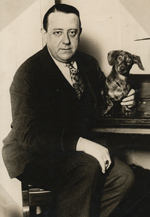
Legitimacy for Children’s Lit: Hendrik Van Loon
and the First Newbery Medal
Journalist, historian, author and illustrator Hendrik Willem Van Loon (1882-1944) came to the United States from his native Netherlands to attend Cornell. He graduated in 1905, and returned to lecture in European History from 1915-16. He wrote and illustrated several nonfiction books for young readers, describing historical events and people in an engaging, anecdotal style. His most famous work, The Story of Mankind, is just that: an illustrated history of Western civilization from cavemen to post-World War I nation states. In 1922 it received the very first Newbery Medal, an award for the “most distinguished contribution to American literature for children.” This was the first award created to recognize excellence in books for young readers, and heralded a new recognition of the genre as actual literature.
 |
Hendrik van Loon. The Story of Mankind. London: G. G. Harrap & Co., 1922. [zoom] |
 |
Hendrik van Loon. Story of Mankind (final chapter). Annotated handwritten manuscript, page 1. [zoom] |
 |
Hendrik van Loon. Sketches and illustrations for The Story of Mankind. [zoom] Additional images:       
|
 |
John Newbery Medal. Bronze. Designed by René Paul Chambellan, 1921. [zoom] The award was proposed to the American Library Association by bookseller and publisher Frederic G. Melcher, who named it after a prolific 18th century English publisher of children’s books. Melcher was also responsible for the Caldecott Award, which recognizes outstanding American picture books, and for establishing Children’s Book Week. |
 |
The Story of Mankind production still photograph. Circa 1957. [zoom] Irwin Allen’s film adaptation imagines a tribunal in outer space to determine the fate of humanity. The Spirit of Man acts as mankind’s defense, while Mr. Scratch (a.k.a. the Devil, played by Vincent Price) is the prosecutor. Evidence is presented by both sides in the form of time travel to specific events in history (as described in the book). The film features an eclectic cast of fading stars: the Marx Brothers, Hedy Lamarr, Peter Lorre, Cesar Romero, John Carradine. One or two rising stars are visible too: Napoleon Bonaparte is played by a young Dennis Hopper. |
 |
Van Loon’s Story of Mankind board game. Parker Brothers, circa 1931. [zoom] Additional images: 
|
 |
Photograph of Hendrik van Loon with his dachshund, undated. [zoom] |
 |
Hendrik Willem Van Loon. “Histoire Fameuse du Sieur Jean Népomuc Pantagruel und von der Hochlöbligen Jung Frau Kunigunde (in 4711 chapters).” Handwritten and illustrated postcards, 1912. [zoom] Additional images:     
In addition to being a scholar and journalist, Van Loon was a family man who loved writing for children. He wrote and illustrated this serial fairy-ish tale for his nieces and nephew and mailed it to them on a series of 93 penny postcards, one by one. Gift of Deborah Rogers. |